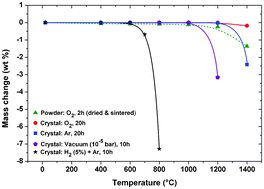Melt-grown bulk In2O3 single crystals were utilized for systematic heat-treatment experiments, which we performed at temperatures of 200–1400 °C, for 2–300 h and in eight different atmospheres, from oxidizing through vacuum to reducing atmospheres. We found that melt-grown In2O3 single crystals are chemically stable up to 1200–1300 °C in neutral and oxidizing atmospheres and up to 1000 °C in vacuum but they readily decompose at 600 °C in a highly reducing atmosphere. Electron concentrations of as-grown In2O3 single crystals were just above 1018 cm−3, which decreased by one order of magnitude after annealing under non-reducing conditions. The electron mobility stayed between 140–180 cm2 V−1 s−1 as long as no decomposition occurred. On the other hand, annealing of the melt-grown In2O3 crystals in hydrogen-containing atmosphere led to an increase of the electron concentration by up to two orders of magnitude (1020 cm−3) accompanied by a mobility drop. Moreover, annealing conditions were identified, within which electron concentrations can be tuned quite precisely. Transmittance spectra revealed a sharp absorption edge at 440 nm. High transparency in the visible range was observed after annealing under non-reducing conditions, whereas in the near infrared region free-carrier absorption played a role in case of high electron concentrations. Further, a broad emission peak has been found by cathodoluminescence at RT in all melt-grown In2O3 crystals, which is independent of any annealing conditions.

You have access to this article
 Please wait while we load your content...
Something went wrong. Try again?
Please wait while we load your content...
Something went wrong. Try again?


 Please wait while we load your content...
Please wait while we load your content...